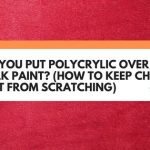Chalk paint is a quick-drying water-based paint that can give wooden furniture a wonderfully matte coat of color.
But, kitchen tables are items of furniture that see a lot of daily use. And while chalk paint looks great, a coat of chalk paint alone can end up flaking off.
So, lets say that you have your heart set on using chalk paint to liven up the look of your kitchen table. What can you do to protect that coat of paint?
And will it be enough to help make sure that color coat truly lasts?
Well, in this post you will find out which two low-maintenance wood sealers are the best options for chalk paint. You’ll also learn what a ‘bonding primer’ is — and why you may need to use one to help seal your kitchen table.

This post may contain affiliate links to products that we receive a commission for (at no additional cost to you). Learn more here.
Will A Few Coats Of Chalk Paint Hold Up For Long On A Kitchen Table Top?
It will…but only if it has also been sealed over with a durable top coating sealant.
Chalk paint on its own won’t last too long on a high-usage surface like a table top. It will need a durable sealer or finish to protect it from scratches, water-damage, and flaking.
And Exactly What Kind Of Sealer Can You Put Over Chalk Paint?
To be honest, most any decent wood sealer will get the job done — that’s provided its a non-penetrating sealant.
Penetrating wood sealers and finishes, (such as Tung oil or Linseed oil), need to sink down into wood to work best. However, a dried coat of chalk paint will prevent penetrating sealers/finishes from sinking past its solid coat of color.
So, this leaves you from choosing from a selection of non-penetrating wood sealers.
But when it comes to kitchen tables, you need a sealer that’s low-maintenance and easy to repair. So you won’t go too far wrong by using either polyurethane or wood wax to seal over chalk paint.
What Happens If You Don’t Wax Or Seal Chalk Paint? It will quickly flake and peel away. And chalk paint on a table top will easily become scratched or water-damaged.
OK…So What Is The Single Best Sealer For A Chalk Paint Coated Kitchen Table?
Well, wood wax is a fantastic option for low-usage surfaces. It isn’t the most durable of wood sealing options. Nevertheless, it is fairly water-repellent, and it is extremely easy to repair if it does become scratched.
But, a table top is going to see a lot of wear and tear — and certainly plenty of water spills. So, you’ll need a sealant that’s more robust when it comes to both water-resistance and scratch-proofing.
Now, polyurethane is a urethane-based wood sealer that has a bit of flexibility to it. That added flexibility allows this sealer to better shrug off scratches than most other sealers.
Also, the chemical make-up of polyurethane makes it more water-resistant than wood wax. This is a distinct advantage to using polyurethane on a high-usage surface such as a kitchen table.
Can You Apply Polyurethane Directly Over Chalk Paint?
You certainly could, provided you’ve allowed the chalk paint time to wholly dry first.
Also, there is another little thing you need to allow for; adhesion.
If chalk paint leaves behind a very smooth surface, you may experience issues with getting polyurethane to adhere to it.
You see, polyurethane will peel off if it’s directly applied onto very smooth surfaces. So, this is why we often need to prep surfaces by sanding them a bit, before we coat polyurethane over them.
Light sanding will roughen things up enough to give polyurethane something to grip onto as this sealant dries and cures. However, the very last thing you want to do is sand and distress a nice coat of paint.
Which is why you may need to use something called a ‘bonding primer’ to help polyurethane out. A bonding primer offers up an easy alternative way to get polyurethane to adhere to a smooth coat of paint.
Exactly What Do Bonding Primers Do?
Well, bonding primers are basically binding agents. They act like a sort of glue in between the base coat (chalk paint) and the top coat (polyurethane).
Now, when it comes to finishing wooden tables, one of the easiest bonding primers you can use is Dewaxed Shellac.
Dewaxed Shellac is a naturally-sourced (and very sticky) wood finish. It’s a glossy finish too, so it will add shine to the otherwise matte appearance of chalk paint.
The unique thing about Dewaxed Shellac finishes is that they stick to most anything. And most things (including polyurethane and chalk paint) will stick to Dewaxed Shellac in return.
On top of that, this wood finish is incredibly easy to apply thinly. But that’s only provided you use a Spray-On Dewaxed Shellac (rather than a brush-on Shellac).
And a thin application of this finish is exactly what you need. Why? Well, because you only need it to act as a binding agent. You aren’t using it as a final top coating finish.
Related Post: Can You Put Shellac Over Paint (Best Practice Revealed!)
So, a single thin coat of Spray-on Dewaxed Shellac will create a sticky enough surface for poly. And once done, you can apply a Spray-on Polyurethane over it.
Now, for best results, there are two key things that are worth emphasizing here:
1). Stick to using Spray-on Finishes/Sealers
If you want to apply thin coats of Shellac or Polyurethane, use the Spray-can versions of either wood finish.
Spray-on application not only saves time, it also reduces the chances of air bubbles appearing in these finishes too.
Related Post: Can You Avoid Dried Air Bubbles Appearing In Your Polyurethane Finish?
2). Stick to using Dewaxed Shellac
Not all shellac finishes are equally suited as bonding primers.
Waxed Shellac sits at the opposite end of the stickiness spectrum, compared to Dewaxed Shellac.
You see, whilst anything will stick to Dewaxed Shellac, next to nothing will adhere to a Waxed Shellac finish.
To Wrap Up, Here Are The 3 Key Takeaways From This Post…
- 1). Chalk paint will flake and peel off if it isn’t top coated with a durable water-resistant sealant.
- 2). Use a non-penetrating wood sealer, such as Wood Wax or Polyurethane, to seal Chalk painted surfaces.
- 3). However, on a high-usage surface, (such as a kitchen table), Polyurethane is more durable than Wood Wax. It is also more scratch-resistant too.



